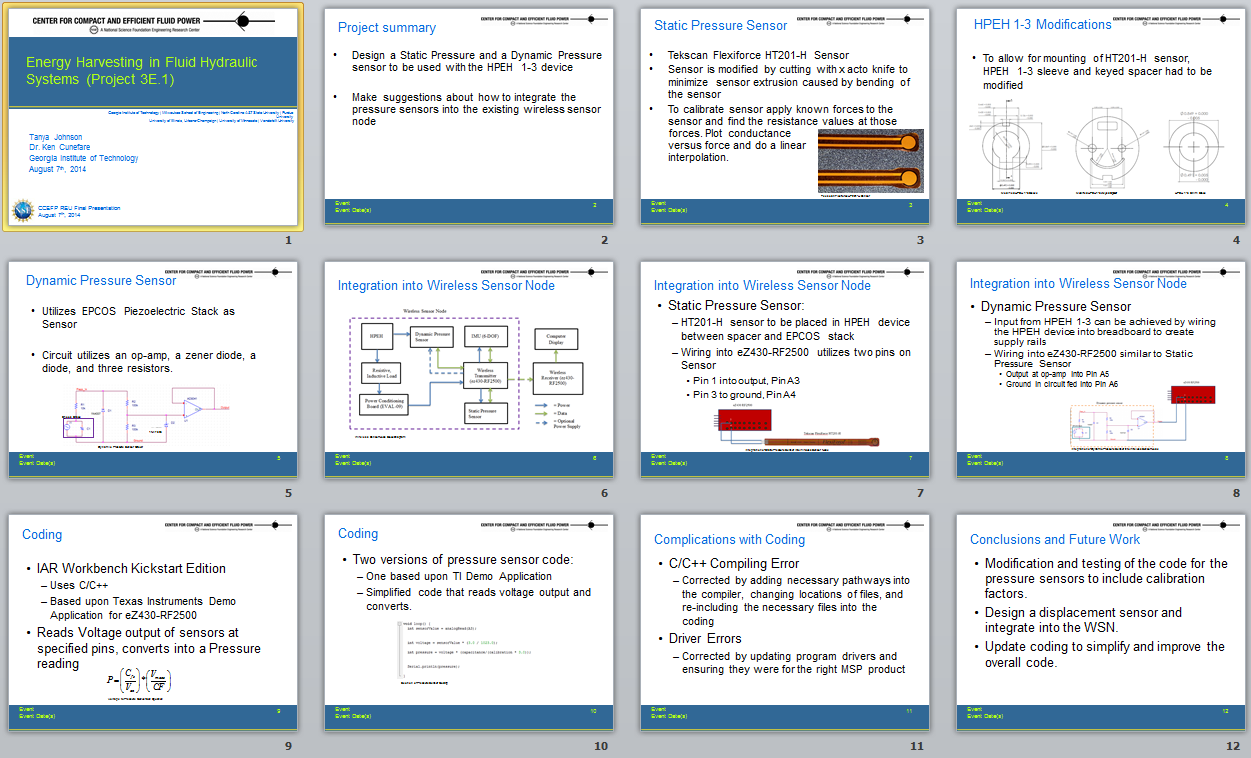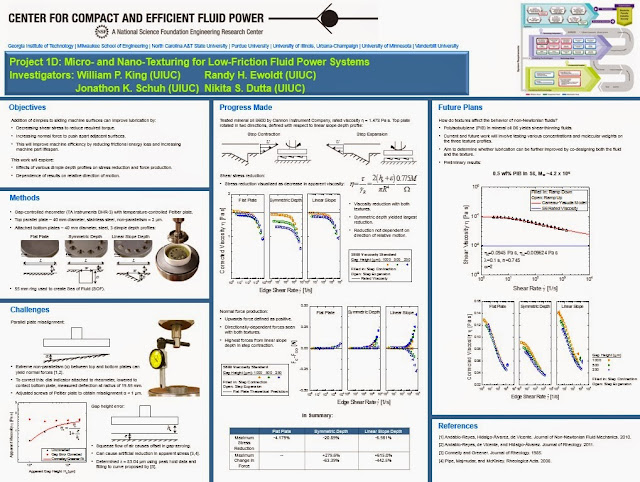The objective of my research this summer was to determine the effects
of CO2 tank cooling as a power source for the Portable Power Ankle-Foot
Orthosis. It was anticipated that fuel usage would increase and
performance decrease due to cooling the CO2 tank undergoes during
operation.
The results showed that fuel was consumed
consistently at all tank temperatures experienced during operation, this
was the opposite of expectations. Also observed was unstable pressure
resulting in unreliable power output from the actuator, and suggestions
were made on possible mechanical systems that could remedy this problem.
This
was all outlined in the following power point presentation, and if
anyone has any questions they can contact me at email at any time.
presentation link:
https://app.box.com/s/g4kifnodzwvo32r0l07c
Timothy Anderson
timothy.anderson-2@mnsu.edu
mechanicalengineer85@gmail.com
Monday, August 4, 2014
Final Post
All great things must come to an end and this incredible experience of conducting summer research at the U of M is no exception. The research process was long and grueling but very rewarding as I learned more in these last two months about practical engineering than I did all year at school. I had many set backs machining parts I needed for my experimental set up and that has taught me that you can't just make everything you draw up in CAD, you have to think HOW you are going to cut each piece and if it will stand up to the stress/pressure you require it to. That being said I did finally create a custom manifold to allow a laser micrometer to record the displacement of check valve poppets under different pressure differentials and tank/load switching frequencies. The final experimental set up (after a lot of headaches and fixing leaks) was the following:
With this set up I recorded the poppets movement and found something interesting! operating at a system pressure of 1500, a tank/load duty cycle of .5, and an experiment running time of 10 seconds I obtained the following result:
You can see as the poppet returns to its seat that it makes a little rebound after the initial contact with the seat! This combined with the pressure sensor data shows great promise that my theory of the poppet rebounding as it hits the seat could be the reason why the check valves leak in switch-mode circuits.
As the reseach begins to windddd down
So I plan to post ONE more time after this as a wrap up, but I wanted to just write to write.
This research has been a blast and the best thing about my summer by far. Hannah and I were able to make it up to Morris to look at an actual Wind Turbine, simply put it was amazing. To be honest it was intimidating to be next to one of these super structures. As the turbine spins in the air, you can literally hear the blades slice through the air screaming. It was pretty inspiring to be honest. Knowing what I am working on could make it to application one day to help improve the green energy effort.
So this entire week I'll be rushing to get my poster work, It's a Monday and our poster is due TOMORROW! So I'll be focusing all my efforts on that now after this post. I hope everyone is thriving with their own REU research.
Week 7
I don't know when I decided to become an engineer.Throughout my life I've learning how to repair and troubleshoot with my father on various projects.
I guess it all started when I was a child (flashback waves) and I would play with my duplo blocks and create many just about anything from buildings to planes. I would at times watch and help my dad fix things around the house.
As I got older I would assist my father in fixing our cars and what a knuckle busting experience that was and still is. If I was to put a time to when I truly decided to become an engineer it was when I was in high school. At first I wanted to make video games which would be software engineering but after that didn't work out I switched over to Industrial and Systems Engineering and kinda fell in love with the manufacturing side of ISE.
Its been kind of a struggle but its well worth it I believe.
I guess it all started when I was a child (flashback waves) and I would play with my duplo blocks and create many just about anything from buildings to planes. I would at times watch and help my dad fix things around the house.
As I got older I would assist my father in fixing our cars and what a knuckle busting experience that was and still is. If I was to put a time to when I truly decided to become an engineer it was when I was in high school. At first I wanted to make video games which would be software engineering but after that didn't work out I switched over to Industrial and Systems Engineering and kinda fell in love with the manufacturing side of ISE.
Its been kind of a struggle but its well worth it I believe.
Friday, August 1, 2014
Final Week
Hello everybody. I'm sure you're all busy preparing your deliverables, but since my partner's SURE Robotics program ends August 1st we have already finished our project. Here's a short refresher of what my project is all about. This is continuation of a project from Lauren's masters thesis and our job was to develop a pneumatic robotic device that can rotate the wrist. This procedure will allow automated performance of repetitive facilitation exercise (RFE) to treat stroke patients and involves synchronizing the brain stimulus with a mechanical stimulus. Currently, RFE is performed by a therapist but the variability is high because RFE requires precision within milliseconds, a feat impossible for humans. The challenge of the project is to make a fully MRI compatible device that is precise, so that RFE treatment can be repeated many times exactly the same way. The overall purpose is to optimize RFE by monitoring a patient through fMRI and to determine the best way to treat stroke patients.
We needed to build a prototype and make sure the accepted precision of the device is within +15 ms and a standard deviation of less than 5 ms. We designed a vane actuator, where compressed air rotates a shaft by pressurizing one side of a chamber. We also fabricated the coupling system between the hand clamp and the shaft, a rotary support to reduce the stress on the shaft, and put everything together from the ground up (note the part with the cylinder was made by the previous year's project). The last step is to conduct experiments to validate the accuracy of the robot. After much difficulty finding an adequate measuring instrument, we finally managed to determine the maximum standard deviation of the vane actuator is 2.9 ms with pressures over 30 psi. Then, a test is conducted on the final prototype with a load and fortunately the maximum deviation is calculated to be 4.4 ms with pressures over 42 psi. All in all, our project did meet the requirements for performing RFE but improvements should definitely be made. For instance, there is a significant amount of air leakage in the vane actuator which means the device is very inefficient. Moreover, the majority of the parts are 3D printed due to time constraints so the device needs to be made stronger.
I definitely learned a lot during my CCEFP experience. As it is my first time being involved in such a program, I figured out you can't be afraid to tackle on new problems. There will always be miscellaneous issues on the way and you can't let it dishearten you. Rather, it is important to struggle and do your best to make the most out of the situation. I had a lot of difficulty manufacturing certain parts for the project, but in the end the hands-on experience taught me much more about design than any class could. Well, I'm still working on my research paper, trying to make it as comprehensive as possible for my adviser, so I'll close off this blog by saying thanks to everybody who made this experience possible. To Alyssa, all my fellow REUs, and those who helped me from the CCEFP!
We needed to build a prototype and make sure the accepted precision of the device is within +15 ms and a standard deviation of less than 5 ms. We designed a vane actuator, where compressed air rotates a shaft by pressurizing one side of a chamber. We also fabricated the coupling system between the hand clamp and the shaft, a rotary support to reduce the stress on the shaft, and put everything together from the ground up (note the part with the cylinder was made by the previous year's project). The last step is to conduct experiments to validate the accuracy of the robot. After much difficulty finding an adequate measuring instrument, we finally managed to determine the maximum standard deviation of the vane actuator is 2.9 ms with pressures over 30 psi. Then, a test is conducted on the final prototype with a load and fortunately the maximum deviation is calculated to be 4.4 ms with pressures over 42 psi. All in all, our project did meet the requirements for performing RFE but improvements should definitely be made. For instance, there is a significant amount of air leakage in the vane actuator which means the device is very inefficient. Moreover, the majority of the parts are 3D printed due to time constraints so the device needs to be made stronger.
I definitely learned a lot during my CCEFP experience. As it is my first time being involved in such a program, I figured out you can't be afraid to tackle on new problems. There will always be miscellaneous issues on the way and you can't let it dishearten you. Rather, it is important to struggle and do your best to make the most out of the situation. I had a lot of difficulty manufacturing certain parts for the project, but in the end the hands-on experience taught me much more about design than any class could. Well, I'm still working on my research paper, trying to make it as comprehensive as possible for my adviser, so I'll close off this blog by saying thanks to everybody who made this experience possible. To Alyssa, all my fellow REUs, and those who helped me from the CCEFP!
Subscribe to:
Comments (Atom)













.JPG)

